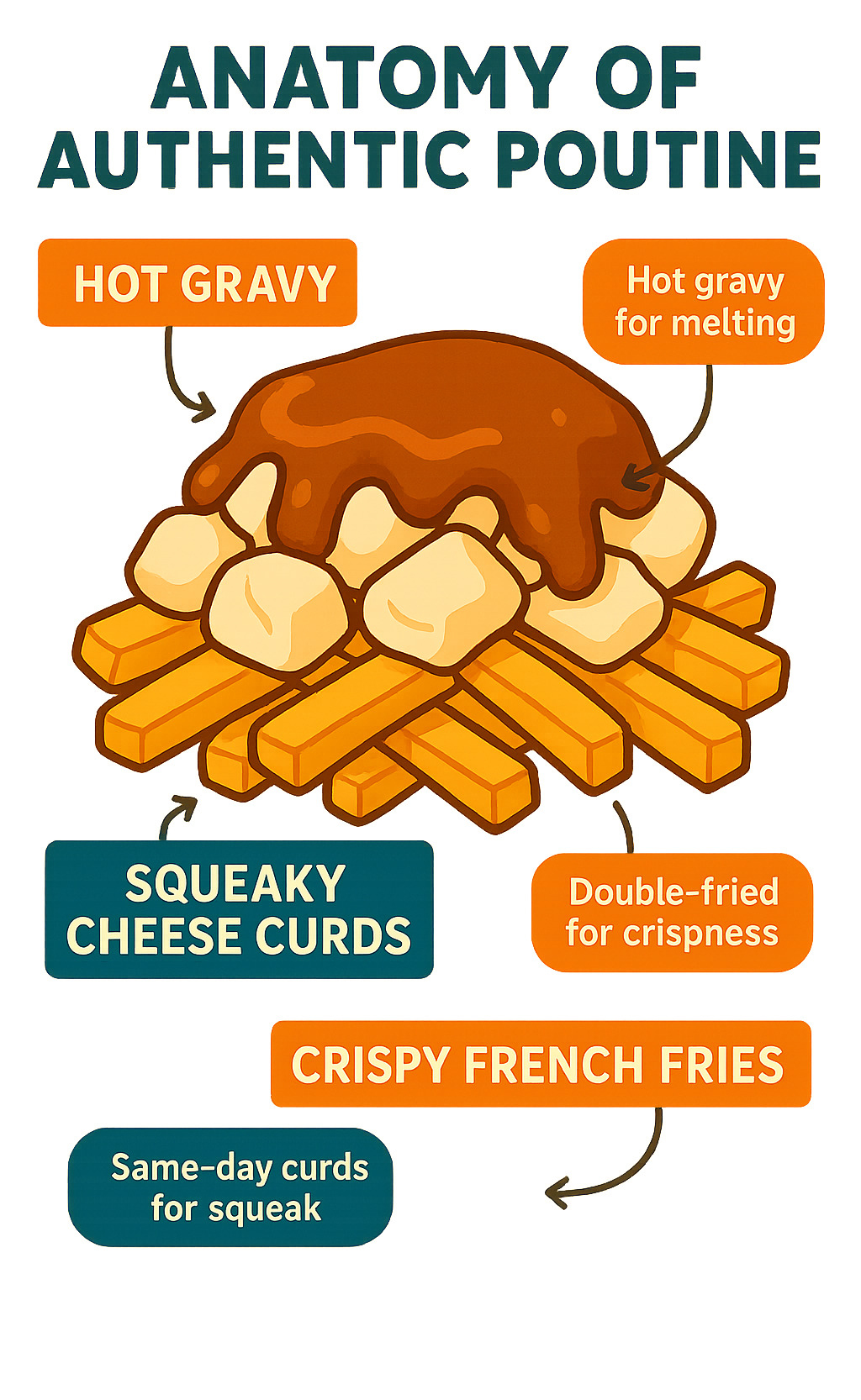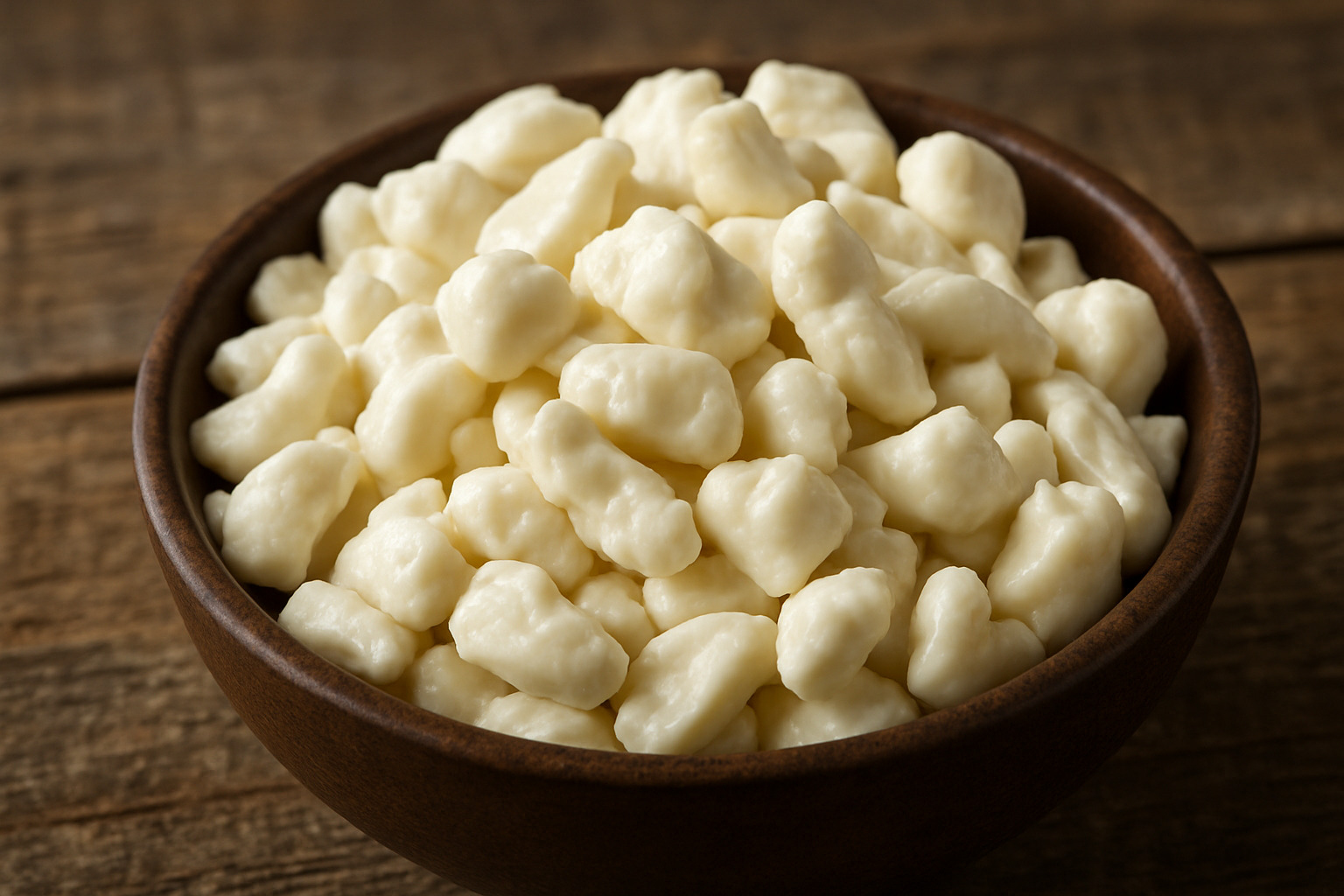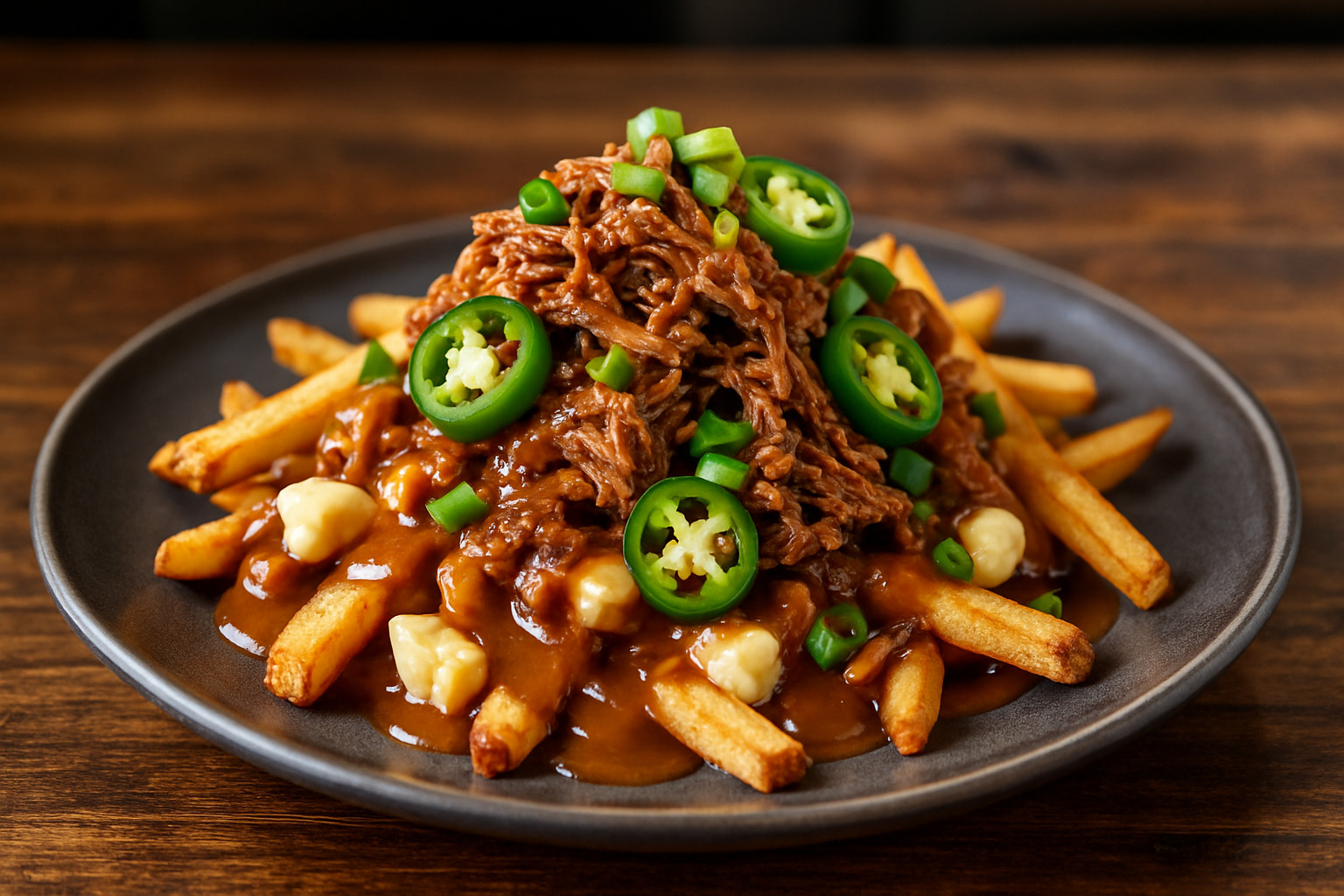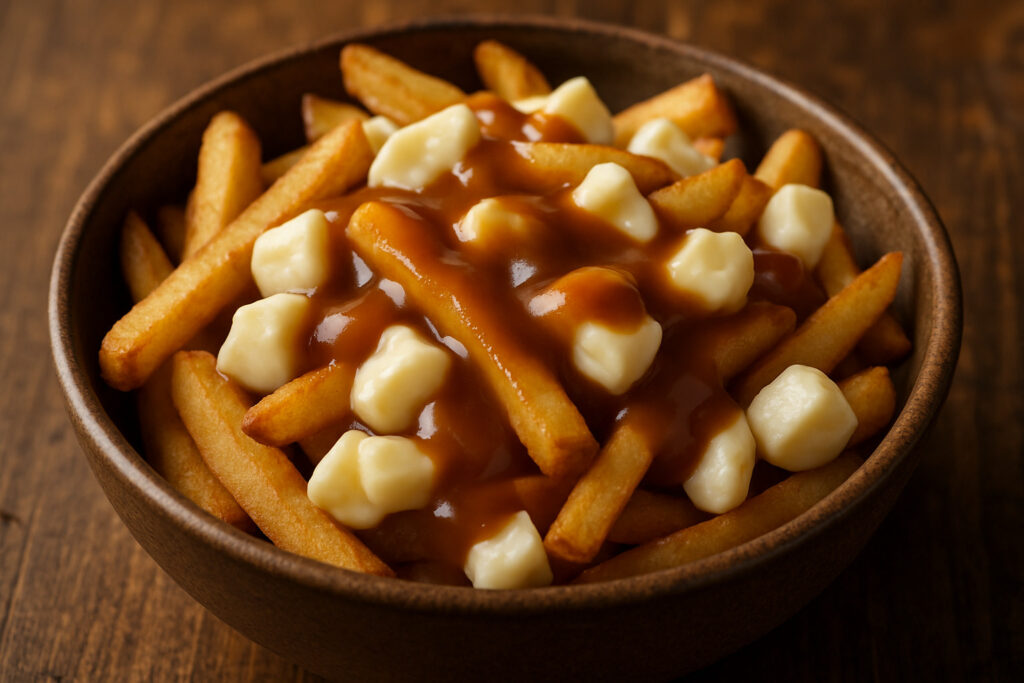What Makes Poutine Canada’s Most Beloved Comfort Food
Poutine is a Canadian dish of crispy french fries topped with fresh cheese curds and smothered in hot brown gravy. This simple yet irresistible combination creates the perfect comfort food that has become synonymous with Canadian cuisine.
Quick Poutine Facts:
- Origin: Quebec, Canada (late 1950s)
- Ingredients: French fries + cheese curds + gravy
- Pronunciation: “poo-TEEN”
- Key feature: Cheese curds must “squeak” when fresh
- Cultural status: Unofficial national dish of Canada
What started as a humble snack in rural Quebec has evolved into a cultural phenomenon. When restaurant owner Fernand Lachance first combined fries with cheese curds in 1957, he reportedly exclaimed “ça va faire une maudite poutine!” – meaning “it will make a damn mess!” Little did he know he was creating what would become Canada’s most iconic dish.
Today, poutine represents more than just late-night comfort food. It’s a symbol of Québécois culture that has spread across Canada and around the world. From food trucks to fine dining restaurants, this dish continues to evolve while maintaining its essential character: the perfect balance of crispy, creamy, and savory in every bite.

Why This Guide Matters
As food tourism continues to grow, poutine has become a must-try experience for travelers visiting Canada. For home cooks, mastering poutine opens the door to understanding one of North America’s most beloved comfort foods. Whether you’re planning a culinary trip or simply want to recreate this iconic dish in your own kitchen, this comprehensive guide will give you everything you need to know.
What Is Poutine?
Poutine might look like a simple plate of loaded fries, but this Canadian comfort food is so much more than meets the eye. While many dishes pile random toppings onto french fries, authentic poutine follows a sacred formula: crispy fries, squeaky cheese curds, and rich brown gravy working together in perfect harmony.
The beauty of poutine lies in its magical change. When hot gravy hits those room-temperature cheese curds, something wonderful happens. The curds start to soften and melt just enough to create creamy pockets of goodness, while still maintaining their distinctive texture. Meanwhile, the fries soak up just the right amount of gravy to become tender inside while staying crispy on the outside.
What makes poutine different from other loaded fries? It’s all about the cheese curds. While other dishes might use shredded cheddar or processed cheese, authentic poutine demands fresh cheese curds that literally squeak when you bite them. The gravy isn’t just any sauce either – it’s a specific light brown gravy made from a blend of beef and chicken stock.
| Feature | Authentic Poutine | Other Loaded Fries |
|---|---|---|
| Cheese | Fresh cheese curds (must squeak) | Shredded or melted cheese |
| Gravy | Light brown, beef-chicken blend | Various sauces or gravies |
| Fries | Medium-thick, often skin-on | Any style |
| Origin | Quebec, Canada | Various |
| Temperature | Hot gravy over room-temp curds | Usually all hot |
The Name & Etymology
Ever wondered why this delicious mess is called poutine? The name comes from Quebec slang meaning “mess” – which is exactly what this dish looks like on your plate! It’s a beautiful, delicious mess that perfectly captures the spirit of comfort food.
The word first appeared in English around 1982, though Quebecers had been using variations of “poutine” to describe different potato dishes since the early 1800s. Here’s a fun pronunciation tip: In Quebec, locals say “poo-tin” (yes, like the Russian president’s name), while English-speaking Canadians typically say “poo-teen.” Both are perfectly acceptable.
Origins in Quebec’s Dairy Country
Poutine was born in the heart of Quebec’s dairy country during the late 1950s. The Centre-du-Québec region was the perfect birthplace, surrounded by some of Canada’s best cheese-curd producers.
Three different Quebec establishments claim bragging rights as the true birthplace of poutine. At Le Lutin qui rit in Warwick, customer Eddy Lainesse asked for cheese curds to be mixed with his fries in 1957. Meanwhile, Le Roy Jucep in Drummondville insists they served the first “real” poutine in 1964. La P’tite Vache in Princeville claims a customer created the dish himself by mixing curds and fries right at his table in 1966.
What’s clear is that poutine emerged from Quebec’s rural dairy region as a practical solution for hungry workers who needed something hearty and satisfying.
The Building Blocks of Authentic Poutine
Creating authentic poutine is like conducting a culinary orchestra – each component must be perfectly tuned to create harmony in your bowl. The magic happens when crispy fries, squeaky cheese curds, and rich gravy come together in just the right proportions.
What separates real poutine from wannabe loaded fries isn’t just tradition – it’s science. The double-frying technique creates fries that can stand up to hot gravy without turning to mush. Meanwhile, the protein structures in fresh cheese curds create that distinctive squeak that signals authenticity.

The Fries
The perfect poutine starts with the right spuds. Russet potatoes are the gold standard here – their low moisture content and high starch levels create fries that are crispy outside and fluffy inside.
Traditional poutine fries are cut into medium-thick strips (about half an inch wide) and often keep their skins on. The secret weapon? Double-frying. First, the fries take a gentle bath at 325°F until they’re soft and pale. Then comes the second fry at 375°F, where they transform into golden, crispy perfection.
Before frying, smart cooks soak their cut potatoes in cold water for at least two hours. This removes surface starch and prevents the fries from sticking together during cooking.
Don’t have a deep fryer? Frozen fries like Ore-Ida Extra Crispy work surprisingly well for home cooks. Air fryers can achieve similar results with less oil.
The Cheese Curds
Cheese curds are the heart and soul of authentic poutine. These solid chunks of curdled milk are captured early in the cheese-making process, before they become aged cheese.
Fresh curds have a rubbery texture and squeak when you bite them. This isn’t just quirky; it’s your quality guarantee. The squeak happens when protein strands rub against your tooth enamel, and it only occurs when curds are truly fresh.
Room temperature curds are crucial for proper poutine. They need to be warm enough to start melting slightly when hot gravy hits them, but not so warm that they turn into a gooey mess. The best curds are used within 24 hours of production.
Can’t find fresh curds? Mild cheddar chunks (never shredded) can work as a substitute, though you’ll miss out on that distinctive squeak.
The Gravy
Poutine gravy is its own special creature. Unlike dark, thick gravy, poutine gravy should be light brown and have a consistency that’s thick enough to cling to fries but thin enough to seep into all the nooks and crannies.
The secret starts with the stock. Traditional recipes use two-thirds beef stock and one-third chicken stock, creating a flavor that’s rich but not overpowering.
A light roux made from butter and flour provides the thickening power, while simple seasonings like salt, pepper, and sometimes a touch of ketchup or Worcestershire sauce round out the flavor.
Vegetarian poutine lovers aren’t left out. Mushroom-based stocks or rich vegetable stocks with umami boosters can create gravies that are just as satisfying as their meaty counterparts.
How to Make Poutine at Home
Making authentic poutine at home is easier than you might think, though it does require a bit of planning to get everything just right. The secret is all about timing – you want those fries hot and crispy, the cheese curds at room temperature, and the gravy steaming when everything comes together.
For those interested in exploring more street food traditions like poutine, check out our comprehensive guide in Street Food Diaries.

From-Scratch Method
The traditional approach takes about three hours from start to finish, but most of that time is hands-off soaking and prep work. You’ll need a deep fryer or large pot with a kitchen thermometer.
Start with the potatoes at least two hours before you plan to eat. Cut two pounds of russet potatoes into half-inch strips and soak in cold water for at least two hours. This removes surface starch and helps create that perfect crispy exterior.
Make your gravy next – you can do this up to 48 hours ahead and just reheat it when needed. Whisk one tablespoon of cornstarch into a cup of chicken stock and set aside. Melt three tablespoons of butter in your saucepan, then whisk in three tablespoons of flour. Cook this roux for about two minutes, then gradually add two cups of beef stock followed by your cornstarch mixture. Simmer until thickened and season with salt and pepper.
The double-frying technique is where the magic happens. Heat your oil to 325°F and fry the potatoes in small batches until they’re soft but not colored – about three to four minutes. Drain them while you increase the oil temperature to 375°F. The second fry takes just two to three minutes and creates that golden, crispy shell.
Assembly is everything in poutine. Place your hot fries in serving bowls, top with room-temperature cheese curds, and ladle the hot gravy over everything. Serve immediately with forks.
Quick Poutine at Home
Sometimes you need poutine on a Tuesday night without the three-hour commitment. Frozen thick-cut fries are your friend here – bake them according to package instructions until they’re extra crispy. While they’re in the oven, make a quick gravy using canned beef and chicken stock with the same butter-flour roux technique.
Warm your cheese curds to room temperature by taking them out of the fridge about 30 minutes before serving. The beauty of this method is that you can have hot, satisfying poutine on your table in about 30 minutes.
Common Mistakes to Avoid
Soggy fries are the death of good poutine. Never use delivery fries that have been sitting around, and make sure your homemade fries are properly crispy before assembly. Once you’ve put everything together, don’t let it sit – poutine waits for no one.
Gravy problems usually come down to temperature and consistency. Keep whisking constantly to avoid lumps, and keep it hot but not boiling when you’re ready to serve.
The cheese situation trips up many home cooks. Never use shredded cheese – it melts too quickly. Don’t microwave your curds until they’re hot either. Room temperature curds melt perfectly under hot gravy, creating those creamy pockets that make poutine so irresistible.
Variations & Regional Twists
While purists defend traditional poutine, creative variations have emerged across Canada and internationally. Montreal’s La Banquise serves over 30 varieties, proving that poutine’s basic formula can support countless interpretations.
These variations often reflect local ingredients and cultural influences, creating fusion dishes that maintain poutine’s essential character while exploring new flavors. What’s fascinating is how each region has made this Quebec classic their own, adding local touches that tell the story of their communities.

Classic Canadian Offshoots
Montreal smoked meat poutine represents Quebec’s ultimate comfort food mashup. This variation layers thick slices of Montreal’s famous smoked meat over traditional poutine, creating a dish that’s both familiar and indulgent.
Alberta donair poutine brings Maritime flavors to the prairies, featuring seasoned donair meat and sweet sauce alongside traditional gravy. This east-meets-west creation reflects Canada’s regional food exchanges.
Prairie pierogi poutine showcases Western Canada’s Ukrainian heritage by combining pierogi with poutine elements. The potato dumplings create an interesting texture contrast while honoring the immigrant communities that shaped prairie cuisine.
Lobster poutine lifts the dish to luxury status, particularly popular in Atlantic Canada’s tourist areas. Fresh lobster meat transforms humble poutine into a celebration of coastal abundance.
Global Fusion Poutines
Korean BBQ poutine reflects Canada’s diverse immigrant communities, featuring bulgogi beef with kimchi and gochujang-spiked gravy. This fusion perfectly demonstrates how poutine can accept international flavors while maintaining its essential comfort food appeal.
Currywurst poutine brings German-inspired flavors with bratwurst and curry-spiced gravy. This variation shows how European influences continue to shape Canadian cuisine.
Breakfast poutine transforms the dish into a brunch favorite with bacon, sausage, and hollandaise sauce replacing traditional gravy. Some versions even add a fried egg on top.
Vegan poutine accommodates plant-based diets using cashew-based cheese alternatives and mushroom gravy. While traditionalists might scoff, these versions often surprise with their rich, satisfying flavors.
The international spread of poutine has led to festival creativity around the world. For more inspiration on global food destinations where you might encounter these variations, explore our guide to the Best Food Destinations.
Poutine Culture, History & Fun Facts
Poutine has come a long way from its humble beginnings in rural Quebec snack bars. What started as a simple “mess” of fries, curds, and gravy has transformed into a powerful symbol of Québécois pride and Canadian identity.
The dish’s evolution mirrors how we’ve changed our thinking about comfort food and regional cuisine. Today, you’ll find poutine gracing the tables at state dinners, food festivals, and even upscale restaurants.
Here are some fascinating facts: poutine is actually younger than many Baby Boomers, having been invented in the late 1950s. English Canada didn’t really accept the dish until the 1990s. The numbers are staggering too – busy poutineries can go through up to 100 kilograms of cheese curds daily, while a typical serving packs about 421 calories with 31 grams of fat. Annual poutine festivals now happen in Montreal, Quebec City, Toronto, Ottawa, and even as far as Chicago.
The ongoing conversations about cultural appropriation reflect just how significant poutine has become to Québécois identity. Some people feel uncomfortable when poutine gets labeled as “Canada’s national dish,” seeing it as appropriation of Quebec culture.

From Snack-Bar to National Treasure
The 1990s marked poutine’s breakthrough moment into mainstream Canadian culture. Major fast-food chains like McDonald’s and Burger King finally added poutine to their Canadian menus, while hockey arenas and cultural events began serving the dish as a matter of course.
Political moments have helped boost poutine’s international profile. When poutine was served at a White House state dinner in 2016, it introduced the dish to American political leaders and symbolized Canada’s unique cultural contributions.
Where to Find the Best Poutine
Quebec remains the heart of authentic poutine culture, with legendary spots like La Banquise in Montreal serving over 30 varieties around the clock. Le Roy Jucep in Drummondville proudly claims to be poutine’s birthplace, while Chez Ashton in Quebec City has built a local empire around traditional poutine.
That said, you don’t need to stray far from The Dining Destination’s home base in New York City to enjoy the real thing. A growing number of specialty food trucks and Canadian-inspired eateries across the city now fry up respectable takes on classic poutine, making it easier than ever for local food lovers to get their squeaky-cheese fix without crossing the border.
The annual “Poutine Week” festival demonstrates the dish’s incredible popularity – in 2021 alone, participating restaurants served over 350,000 poutines to eager fans.
Frequently Asked Questions about Poutine
Is there an acceptable substitute if I can’t find cheese curds?
Finding cheese curds outside of Quebec can feel like searching for culinary gold, but don’t let that stop you from making poutine at home! While purists might raise an eyebrow, there are workable substitutes that’ll give you a delicious result.
Your best bet is chunks of mild, low-moisture mozzarella torn into 1-2 inch pieces. The key word here is “chunks” – avoid fresh mozzarella (it’s too wet and will make your fries soggy) and definitely skip shredded cheese (it melts too quickly and won’t give you that satisfying bite). Some home cooks swear by mild white cheddar cut into chunks, which provides excellent flavor even without the signature squeak.
The truth is, while these substitutes won’t give you that authentic “squeak” that makes cheese curds so special, they’ll still provide the proper texture and melting characteristics that make poutine so irresistible. The goal is chunks of cheese that partially melt when hit with hot gravy while maintaining some structure.
What gravy should I use for vegetarian poutine?
Creating vegetarian poutine doesn’t mean sacrificing flavor – it just requires a little creativity with your gravy base. Mushroom-based gravies are absolutely fantastic for this purpose and often taste so rich that even meat-eaters can’t tell the difference.
Start with a combination of mushroom and vegetable stocks as your base, then boost the umami factor with ingredients like soy sauce, nutritional yeast, or mushroom powder. Some creative cooks incorporate miso paste for depth, while others rely on vegetarian Worcestershire sauce to add that complex, savory note.
The secret is achieving that same light brown color and smooth consistency as traditional gravy. Don’t worry about it being “different” – focus on making it delicious. Many vegetarian poutine lovers actually prefer mushroom gravy because it adds an earthy richness that complements the cheese curds beautifully.
Can I make the fries ahead and freeze them?
This is one of our favorite poutine prep tricks! Not only can you make fries ahead and freeze them, but doing so actually improves their texture – it’s like a secret weapon for home cooks.
Here’s the game-changing technique: after completing the first fry at 325°F, drain the fries completely and spread them on baking sheets. Pop them in the freezer until they’re frozen solid, then transfer to freezer bags where they’ll keep beautifully for up to 3 months.
When you’re ready for poutine night, fry directly from frozen at 375°F until golden and crispy. The science behind this is fascinating – freezing actually breaks down cell walls, creating fluffier interiors while maintaining that crispy exterior we all crave.
This method is perfect for meal prep or when you want to serve poutine to a crowd. You can literally have restaurant-quality fries ready in minutes, making homemade poutine much more accessible for busy weeknights or impromptu gatherings.
Conclusion
Poutine represents more than just a dish – it’s a beautiful example of how humble ingredients can create something truly magical. From its accidental beginnings in rural Quebec snack bars to its current status as Canada’s beloved comfort food icon, this wonderfully messy dish continues to win hearts while staying true to its roots.
Whether you’re planning your next culinary trip or just want to bring a taste of Canada into your kitchen, understanding authentic poutine gives you so much more than a recipe. You’re connecting with a piece of Canadian culture that brings people together over shared plates and satisfied smiles.
The beauty of poutine lies in its accessibility. You don’t need exotic ingredients or complicated techniques – just good fries, squeaky cheese curds, and proper gravy. Yet achieving that perfect balance of crispy, creamy, and savory takes practice and respect for the dish’s traditions.
As food tourism continues to flourish, poutine serves as the perfect gateway into Canadian cuisine. It’s comfort food at its finest, telling the story of Quebec’s dairy country while welcoming creative interpretations from around the world. We encourage you to seek out the real deal during your travels – there’s nothing quite like experiencing authentic poutine in its homeland.
For those inspired to explore more culinary journeys, find what’s trending in food travel through our comprehensive guide to culinary travel trends. At The Dining Destination, we’re passionate about connecting food lovers with authentic experiences that celebrate the stories behind dishes like poutine.
Whether you pronounce it “poo-teen” or “poo-tin,” one thing’s for certain: this delightfully messy Canadian classic will continue bringing people together, one squeaky bite at a time.







